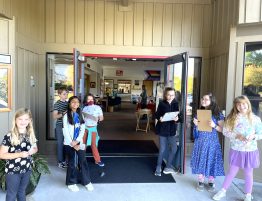
I am delighted to introduce to you the St. Gabriel Creation Care Team. The team consists of myself, my husband, Gary, our Junior Warden, Gene Dietzman, Ian Smith, and Diane Leonard. Our group was formed because our Diocese announced a call for all churches in the Diocese to become carbon-neutral by the year 2030. This was announced during last fall’s annual meeting. It aligns with the National Episcopal Church’s carbon-neutral-by-2030 mandate, which was adopted at the 2022 General Convention.
Carbon-neutral by 2030. What does that even mean, and how on Earth do we get there? Basically, becoming carbon-neutral means to “eliminate carbon emissions from a building and church operations so that no carbon (carbon dioxide, methane) is added to the atmosphere.” (CCWG) This is a big goal, with a short timeline.
there? Basically, becoming carbon-neutral means to “eliminate carbon emissions from a building and church operations so that no carbon (carbon dioxide, methane) is added to the atmosphere.” (CCWG) This is a big goal, with a short timeline.
The exciting thing about our position here at St. Gabriel is that we have an aging HVAC system – or really, just HV system, because we have no AC at all, and we need it. This puts us in the perfect position to transition away from fossil fuels if we choose to do so. Our current heating system burns natural gas, and it alone is responsible for 80% of the carbon emissions of our building.
So, what alternatives might there be? Many of you are probably already thinking the next two words I’m about to say – heat pumps. Probably many of you already use heat pumps for your home HVAC. They use a remarkable technology that is able to produce far more heating or cooling that the electricity it takes to run them, and they provide not just heating, but air conditioning, too. Now, another thing to know is that heat pumps for HVAC come in two flavors – air to air and geothermal. One uses outdoor air as the heat reservoir, and the other uses the Earth as the heat reservoir. (It’s not that you have to drill down till the Earth actually gets hot, it’s just that the temperature of the ground at 6 ft depth or more remains a relatively constant 50-60 o year-round, and you take advantage of that fact to run the heat pump.)
Geothermal heat pumps are the most efficient, lowest maintenance HVAC technology currently available. They have a high upfront cost, but are usually warrantied for much longer than it takes for them to pay for themselves in utility bill savings.
Heat pumps, whether air-to-air or geothermal still use electricity, so if that were the only change we made here at church, it would reduce our carbon footprint by a huge amount, but it would not get it to zero. To do that, we would want to consider installing a solar array. In fact, because of all this work for St. Gabriel,
Gary and I are in the midst of having a solar array installed for our home (we already have a heat pump).
Even before installing a heat pump system or solar array, we will want to tighten up our building envelope as best we can, so we are not installing systems that are larger than we actually need. Also, since HVAC decisions and install will not happen before this summer, we are working to find low-tech solutions to help us get through this coming summer in some degree of comfort.
One thing I really do need to mention is that even though things like geothermal heat pumps and solar arrays are expensive, there are grants, incentives, and rebates available to make these systems much more affordable. In fact, there is a 30% rebate that has long been available to homeowners for installing these systems, and that rebate is now available to houses of worship through the Inflation Reduction Act.
Your Creation Care team has a big job. We will be collecting proposals from contractors, investigating funding opportunities, and learning how we might achieve the goal of carbon-neutral by 2030 here at St. Gabriel. We will present our findings and offer choices for you and the Vestry to make.
If you have experience with any of the technologies I have mentioned, we would like to hear from you. If you would like more information about Creation Care as a church-wide initiative, you will find links to Creation Care on both the Diocesan website and the website of the national Episcopal Church. And of course, we your team members are available to answer any questions we can.
I would like to offer one final image that I find lovely. Creation Care as a mission has come about because we wish to care for our Lord’s beautiful creation. If we are somehow able to utilize geothermal HVAC here at St. Gabriel, getting our heating and cooling from the Earth, and solar panels getting our electricity from the sun, then not only will we be caring for creation, but creation will quite literally be caring for us.
~Henrietta Laustsen
image from wattsstreet








